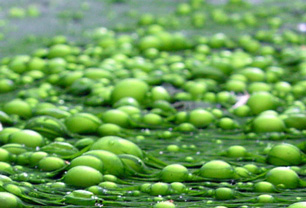Algae and Cyanobacteria
|
EPA Maximum Contaminant Level Goal (MCLG) |
Total Coliform | zero |

Algal blooms in northern France, caused by an overabundance of fertilizers.
Algae and cyanobacteria (also known as blue-green algae) are microscopic organisms found in nutrient-rich water.
In still water, cyanobacteria can form colonies or “pond scum” visible to the naked eye. While most algae are harmless, some cyanobacteria release toxic compounds called cyanotoxins that can be harmful to human health, especially in highly concentrated blooms.
Algae can give drinking-water a musty odor and undesirable taste.
Health Effects of Algae and Cyanotoxins
Cyanotoxins released by some cyanobacteria can cause allergic reactions, stomach cramps, nausea, headaches, fever, sore throat, muscle and joint pain, oral blisters and liver damage.
Long term exposure can lead to more serious health conerns, according to the EPA:
Continuous sublethal or low-level exposures to cyanotoxins can potentially lead to the development of gastrointestinal, neurological, and liver disorders.
Water Treatment for Algae and Cyanotoxins
Activated carbon is effective, and can resolve taste and odor issues. Reverse osmosis (RO), nanofiltration and ultrafiltration will remove/reduce single-cell cyanobacteria, and possibly the resulting cyanotoxins. Chlorination can kill cyanobacteria but does not filter away cyanotoxins.
One pool expert writes, “The ONLY sure-fire method of destroying waterborne algae is by running the water through an ultraviolet light. UV lights sterilize the algae and prevent it from reproducing. It will clear up the water and keep it clear. When installed correctly, a UV will show outstanding results within a matter of a day or two.”
Sources: Water Technology, EPA, World Health Organization, The Original Pond Doc, Photo: WikiMedia, author: F. lamiot
Site Index
Filtration Systems
- Aeration for Iron & Sulfide
- Backwashing Filters
(whole house & well units)
- Chlorine & Chemical Injectors
- Countertop Water Filters
- Garden Hose Filters
- Reverse Osmosis, Residential
- Reverse Osmosis, Commercial
- Shower Filters
- Specialty Filters
- Ultraviolet Systems
- Undersink Filters
- Water Softeners
- Whole House Filters
Cartridges
Parts
- Replacement Parts
- Faucets
- Filter Media
- Fittings
- Housings
- O-rings
- Pumps
- Pura UV
- R.O. Parts
- R.O. Tanks
- R.O. Booster Pump
- VIQUA UV